14 Mistakes Almost Everyone Makes With Scallops
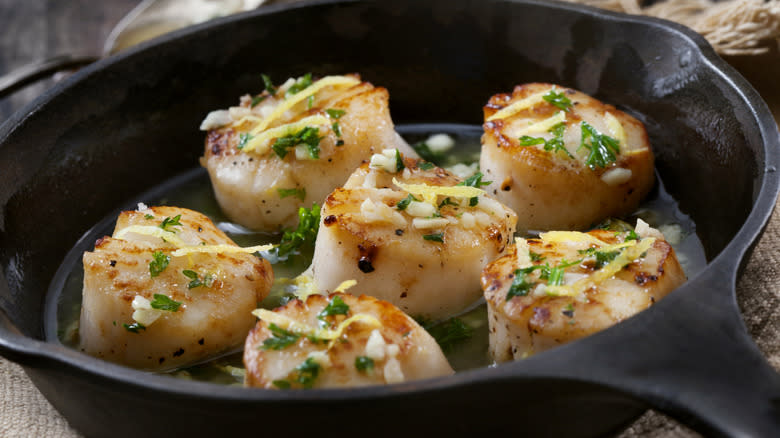
Scallops are a classy choice. These bivalve mollusks contain within them a perfectly formed chunk of meat, which you can typically find on the menus of high-end bistros and restaurants worldwide. But part of the reason why scallops are so prized (and expensive) in eateries is because restaurateurs often have the skill to cook them way better than home chefs do. Scallops are deceptively tricky to cook and can be overdone in a matter of mere seconds, becoming rubbery and almost inedible. The fear of this, however, can often lead people to undercook them, again leaving them tough and lacking in texture.
Scallops can also be pretty hard to sear effectively due to their high moisture content and the high heat needed -- and it can be difficult to know exactly which flavor complements them best. And all of these things are dependent on you buying the right scallops in the first place, which can be more complicated than it seems. These errors, however, can be avoided with a few simple tips and tricks, and before you know it, you'll be making restaurant-quality scallops in the comfort of your own home.
Read more: 12 Underrated Types Of Fish You Should Try At Least Once
Buying The Wrong Type For Your Recipe
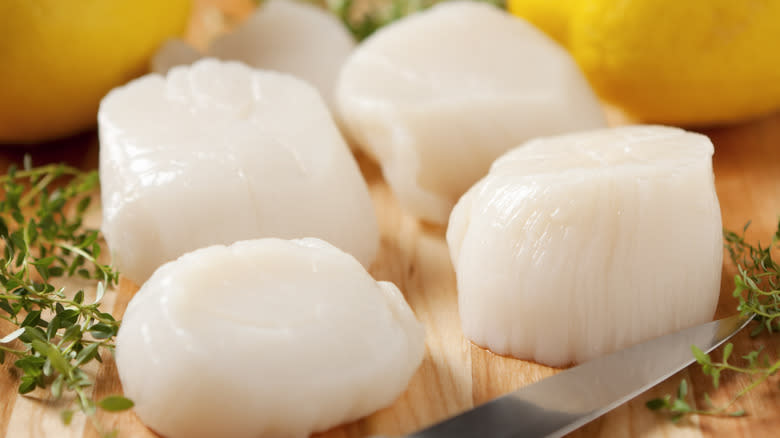
Scallops may seem simple enough to buy, but there's more to it than you think. Crucially, there are several different types of scallops, and each one has a different size and flavor. The two most common varieties are bay scallops and sea scallops. Sea scallops, as you might expect, are found in the cold waters of the ocean, and are the largest kind, measuring a few inches in diameter. They usually have a fairly strong, sweet, sea-like flavor, and dense flesh.
Bay scallops, on the other hand, are way smaller. Found in shallow bay waters, bay scallops tend to have a much gentler flavor than sea scallops, and a way softer consistency. The type you choose will have a pretty big impact on your recipe. If scallops are the centerpiece of the meal, choosing sea scallops, with their larger size and stronger flavor, may be preferable. Sea scallops are also better when paired with a robust sauce that can combat the briny notes in them. Bay scallops, on the other hand, are better suited for things like mildly-flavored pasta dishes made with butter or lemon, as their small size makes them easier to maneuver and their milder flavor won't be overpowered.
Cooking With Wet Scallops
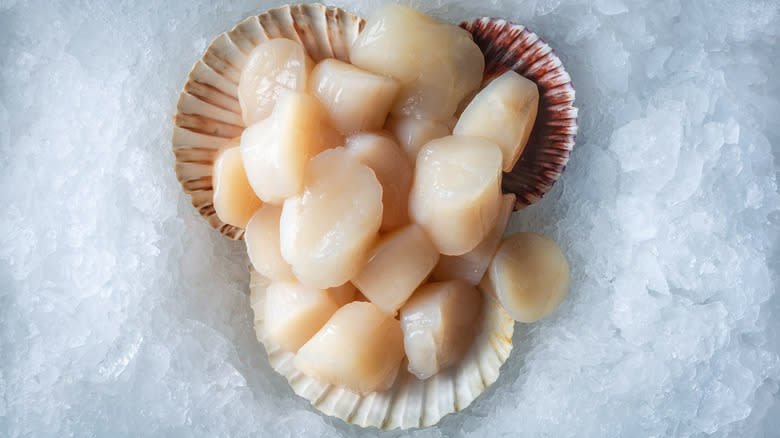
The term "wet scallops" might seem a bit obvious: After all, scallops come directly from the sea, so aren't they all sort of wet? It's not that simple. A "wet scallop" refers to a scallop that's undergone additional processing after being harvested, which can ruin its consistency.
Wet scallops are preserved with a substance called tripolyphosphate, which makes them juicier -- but causes cooking issues. "They're essentially part water product, like a ham, and they don't cook as well because they won't caramelize," says Matt's Cape House owner Dan Sweeney, via CTPost. "The water comes out of them, and they more or less simmer." Wet scallops can also have an unpleasant chemical, soapy flavor due to the tripolyphosphate. Their texture can also be more jiggly, giving none of the firmness that you would expect from a well-cooked scallop.
Instead, you should always try to find dry scallops. There are a few ways of figuring out which are dry and which are wet. The first clue is, of course, that the scallop you're purchasing is surrounded by liquid, which is usually opaque or milky-looking. For packaged scallops, always make sure you look at the ingredients to see if any preservatives are listed. Buying scallops from a fishmonger can help you figure out whether your product is wet or dry, as they should know the origins of the scallops and how they've been treated.
Falling For Fake Scallops
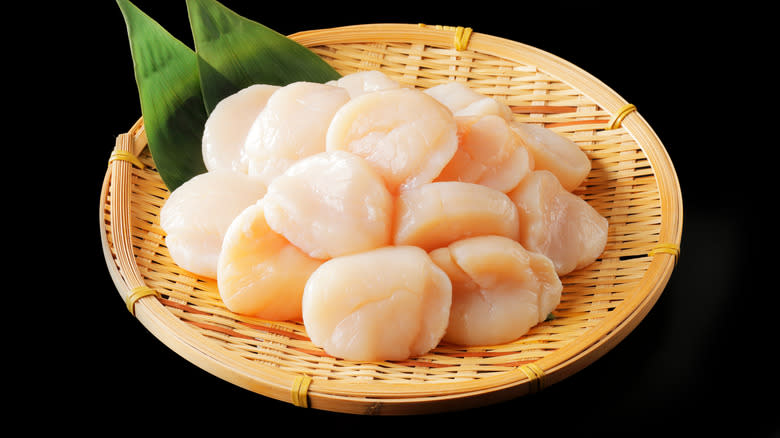
Seafood fraud is an enormous issue worldwide, with multiple studies finding that many fish and seafood items are routinely mis-sold or mislabeled, both in restaurants and in supermarkets and fishmongers. Scallops aren't immune to this. One study published in Food Control found that almost half of all king scallops sold in Germany were actually Japanese scallops.
But arguably, a bigger issue is when the scallops you buy aren't actually scallops at all -- and it's something that happens more often than you think. Scallops are frequently faked, and what looks like the fish product can, in fact, be a different type of seafood, cut with a mold to resemble the mollusk. Some fake scallops are formed from surimi, a type of fish paste made from cheaply sourced fish, or alternatively made from stingray, shark, or skate.
One of the best ways to tell whether a scallop is fake or not is to look at its shape. As fake scallops are formed from a mold, they tend to be uniform, whereas real scallops can be slightly irregularly shaped. Scallops also have a sweetness to them that surimi doesn't quite nail. The texture of fake scallops is also different and tends to be fairly spongy and totally regular, whereas real scallops have some differentiation to them.
Assuming You Should Always Buy Wild Scallops
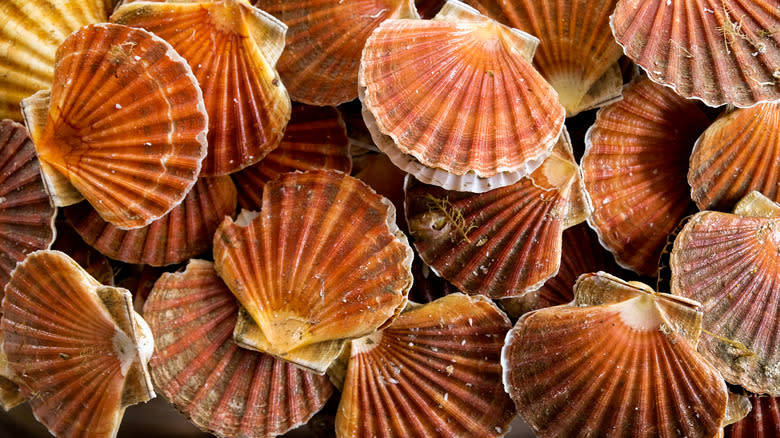
Farmed vs. wild is one of the biggest questions when it comes to buying fish, and some varieties are usually better than wild-caught. With scallops, though, it's a different story. While regular fish farming can be destructive to the environment and create food chain issues, bivalve farming may actually improve ecosystems, according to a 2021 study. Bivalves like scallops can help to filter water and keep it clean, meaning the more of them there are, the better quality the ocean water is. Farming scallops also doesn't impact the environment heavily, and as they don't require food to be bought for them to feed on, they don't disrupt the natural order of things.
As well as this, farmed scallops may also help to improve wild scallop stocks. Not only does buying farmed scallops decrease the pressure on wild scallops, but their breeding patterns may cause wild scallops to grow in greater numbers. When buying farmed scallops, however, it's always best to try and buy them as locally as possible. You don't want your decision to be made worse by importing a food product from the other side of the world and therefore buying into the travel costs and any impact that said travel can have on the environment.
Trying To Thaw Them Too Quickly
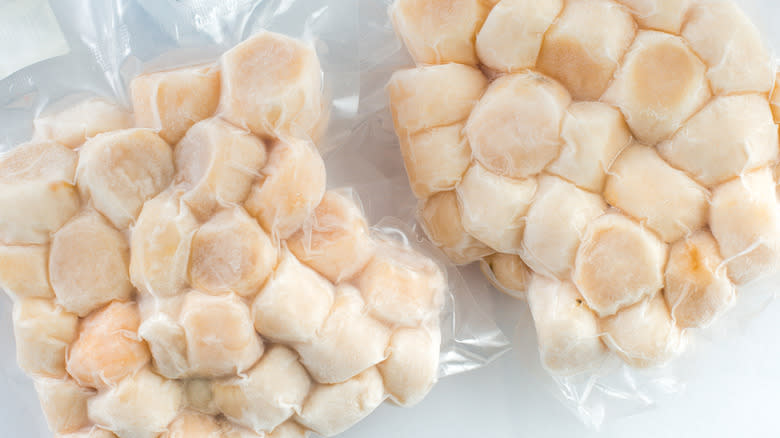
Freezing scallops is a great choice if you're not planning on eating them immediately, and when stored properly, they can last for up to three months. But when it comes to eating them, way too many people try to speed up the defrosting process by using hot water or the microwave. This should always be avoided. Scallops are small, delicate things, and blasting them in the microwave or dousing them with hot water can start to cook them. This can happen even if you're using the defrost setting on your machine.
Instead, you should allow your scallops to thaw gently. Take them out of the freezer and place them in a container in the fridge, leaving them overnight if possible. Doing this keeps them out of the so-called "danger zone," the temperature range in which bacteria can grow, which your scallops can reach if you leave them on the counter. Running cold or lukewarm water over the scallops in the sink can also defrost them more speedily. Just make sure that you don't splash water everywhere as you do this, as any food splashes that then warm up could potentially become a breeding ground for bacteria.
Forgetting To Pat Your Scallops With Paper Towel
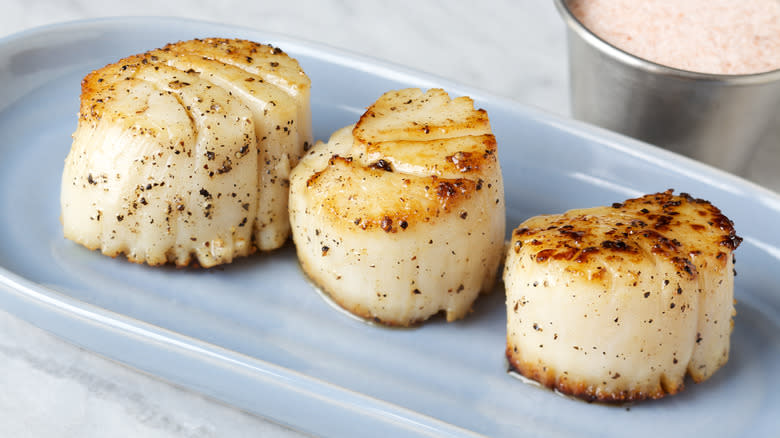
A large part of what makes a fried scallop great is the sear. Searing your scallops effectively gives the exterior a golden-brown crust and a deeper flavor. And this just can't be achieved if you're not patting them dry. Scallops can retain moisture pretty well, both inside their flesh and on their surface. When that moisture hits the pan, it gets in the way of the dry heat needed for the Maillard reaction to occur. Instead, the scallops start to steam, and the temperature of the pan gets brought down.
But by patting them dry, you can remove any excess water or liquid on the outside of the scallop and, therefore, remove the chance of steamy scallops. Make sure you use a thick paper towel to avoid it breaking apart as you pat. You can also use a clean tea towel to do this. Whatever you choose, though, make sure that you're disposing of or washing your chosen item quickly. Leaving it around on the counter will increase the likelihood of bacteria spreading and possible foodborne illness.
Using The Wrong Fat To Sear Scallops
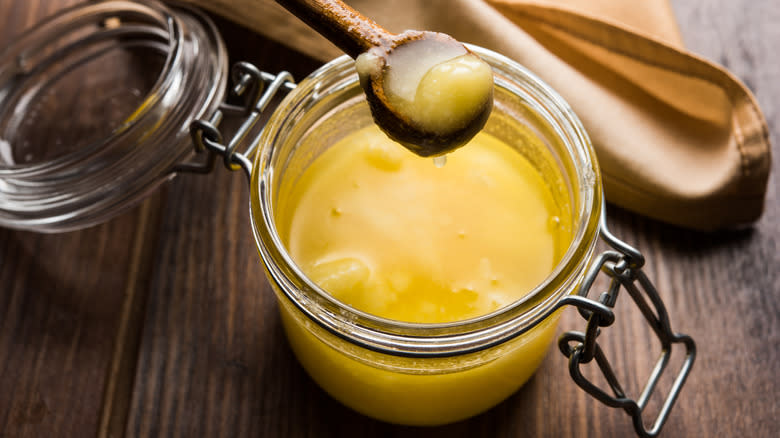
Fat is essential when cooking scallops. As the seafood is naturally low in fat, it won't release any when heated up, and therefore, additional fat provides flavor and improves its ability to sear. But where people usually go wrong is picking the wrong fat to do this. Scallops need an incredibly high heat to sear properly, around 450 degrees Fahrenheit. This is above the smoke point of many fats, and when they reach the temperature they smoke at, they release acrid smells and tastes into your food.
This, unfortunately, includes regular butter, which most people think of as the best option for scallops. Butter's smoke point is roughly 350 degrees Fahrenheit, which is way too low. Olive and canola oil will also struggle at this heat. Luckily, you can still achieve a buttery taste for your scallops by using clarified butter, which has a much higher smoke point. Peanut oil is also a great option, as it's able to withstand those higher temperatures.
Remember, too, that you don't have to cook scallops in butter in order to get the taste of it. If you're cooking your scallops in peanut oil, simply pour some melted butter over them before serving.
Forgetting To Use A Brine
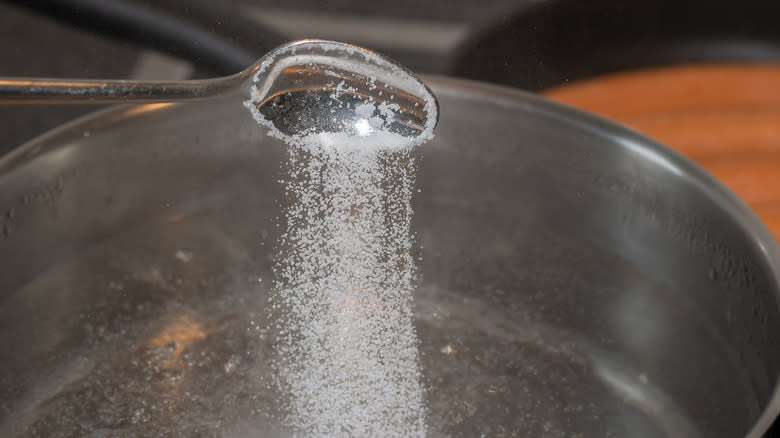
If you've picked up wet scallops from the store, it can feel like your meal is totally ruined. The higher water content of wet scallops seemingly makes them near-impossible to sear. The key, though, might seem counterproductive: To remove the water, you first need to add more.
Placing wet scallops in a brine helps to draw the chemical solution known as tripolyphosphate (or sodium tripolyphosphate, or STP) -- which the wet scallops are packed in -- out of the meat. As the STP is pulled out, so is the water that it holds on to. Bringing your scallops can also help to flavor them from the inside, making an altogether more juicy product. It will also rid the scallops of the strange, somewhat chemical taste that STP gives them.
You can make a simple brine by mixing a few cups of water with some tablespoons of kosher salt. If you want to make the scallops even more flavorful, squeeze in a spritz of lemon juice. Luckily, scallops don't need to brine for long to achieve the desired effect: You can remove them after 10-15 minutes. Just make sure that you dry them thoroughly before cooking them.
Overcooking Them
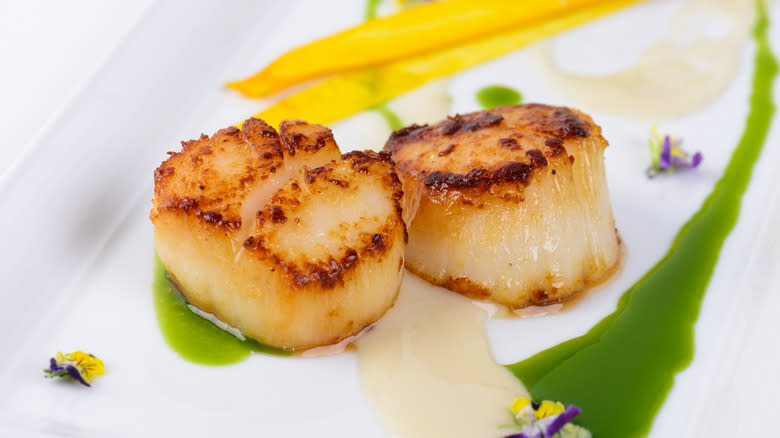
Few ingredients go from perfectly cooked to overdone as quickly as scallops do. These small pieces of meat need mere minutes to cook, and because you're working with super-high temperatures, leaving them in the pan for even just a few extra seconds can ruin their texture. When scallops are overcooked, they become rubbery, overly firm, and unpleasant to eat.
To cook scallops perfectly, aim to cook them for just a few minutes on each side. Make the initial sear on one side of the scallop for two minutes or so, and then flip them over, finishing them off with a quick blast of heat. The best way to check if they're done is to poke them in their center. If the flesh springs back, it's good to go. If it doesn't, then it's likely that the scallop needs a bit more time to firm up in the heat. If, however, the scallop feels tough to the touch, then you've probably overcooked it. Bear in mind that even if you turn the heat off in your pan, if you leave the scallops in it, the residual heat will continue to cook them.
Coating Scallops With Spices
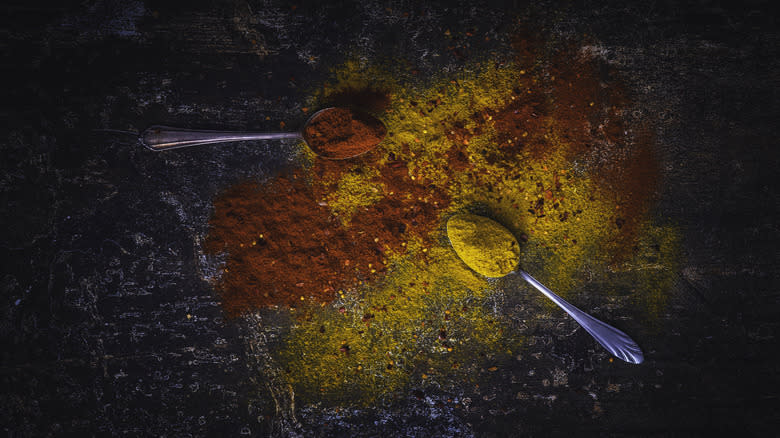
As scallops have such a mild flavor, it can be tempting to really bulk them out with the addition of spices. But this is pretty much the worst thing you can do to your meal. Coating scallops with spices can create a weird paste-like consistency on them when they're cooked. This not only ruins the consistency of the food but the taste, too. Either the paste flakes off while you're trying to eat the scallops, leaving you with an irregular-tasting piece of food, or it completely overrides the natural flavors in the seafood.
There's also the risk of burning to consider. Frying spices at the high heat that cooking scallops requires risks them burning. This is made even riskier by the fact that you need a dry heat to get a proper sear on scallops, which can scorch the spices. Rather than destroy your meal, it's best to keep your additions light before you cook them. It's usually enough to add some flaky sea salt and add any spicier elements once the scallop is cooked. While you can add black pepper before cooking them, bear in mind that it can also burn easily.
Using Overpowering Flavor Combinations
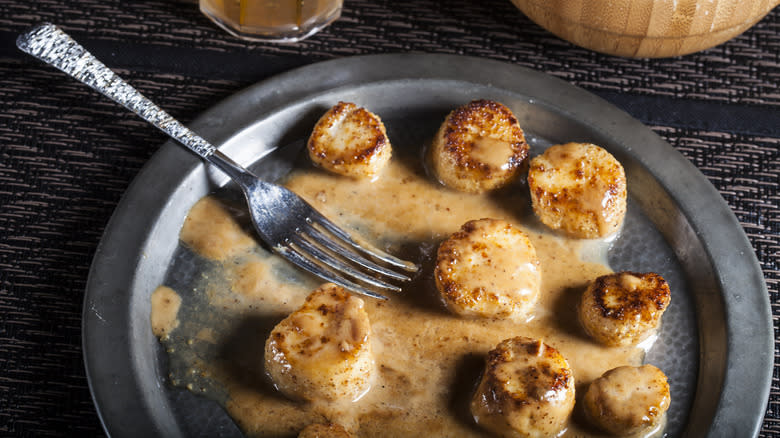
Scallops may have a subtle taste, but that doesn't mean that they go with everything. In fact, the opposite is true. The light fishiness and sweetness of scallops mean that when they're combined with delicate, sharp flavors, they sing -- but when you throw harsh, spicy, or particularly acidic elements at them, they just don't go together.
One flavor profile you'll want to avoid as much as possible is tomatoes. Tomatoes have an umami-rich, acid-heavy flavor, and while that works with many ingredients, scallops tend to be overwhelmed by them. Cream-based sauces are also a little hit-and-miss. The dairy content in the cream can again overpower the scallops, and the seafood's combination of sweetness and saltiness doesn't quite work. Butter, the flavor of which is less dense, doesn't usually have the same issue.
To stay on the safe side, we'd recommend going for light yet sharp ingredients. Simple additions like lemon juice or sautéed garlic bring out the natural flavor of scallops while offering a contrast to their gentleness. Spring onions, mustard, and chili flakes all also work well with the seafood.
Jiggling Your Pan
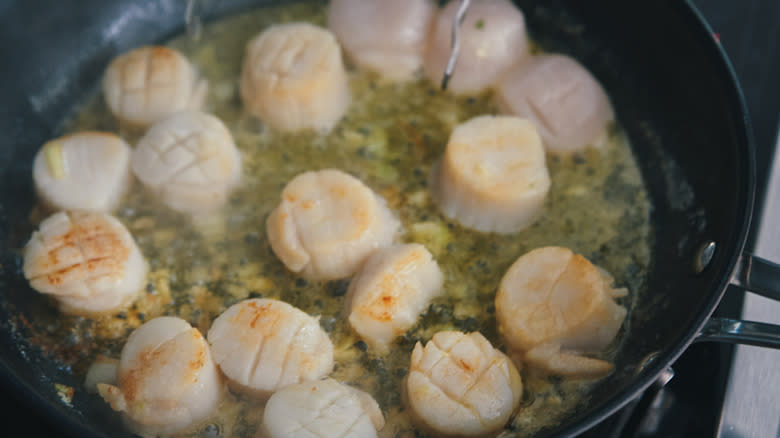
Jiggling a pan while your food cooks may make you feel like a professional chef, but you should stop and ask yourself why you're doing it. "There's no reason to stand there and shake the pan," The Wine Bar and Bistro on Lark in Albany's executive chef Jason Baker told CTPost. By fussing with your pan, you risk upsetting the contact between the scallop and the meal and the seal that needs to form to generate the crust. In the worst-case scenario, your scallop will cook through before you gain a consistent brown coating.
Conversely, you should just let things be. "Put it in the pan, make sure you hear it sizzle, and then leave it alone. Don't touch it," Baker states. Instead, you should work by timings and temperature. If your pan has reached the optimal temperature of 450 degrees Fahrenheit, it should take a couple of minutes for it to brown. Don't pick it up to check whether it's there yet -- leave it be to give it the maximum and most consistent heat possible. If you're worried about the scallop sticking to the pan, make sure you use a well-seasoned skillet. Bear in mind that nonstick coatings, like Teflon, can deteriorate when pans are heated to extra-high temperatures without any food in them.
Always Cooking Them On The Stove
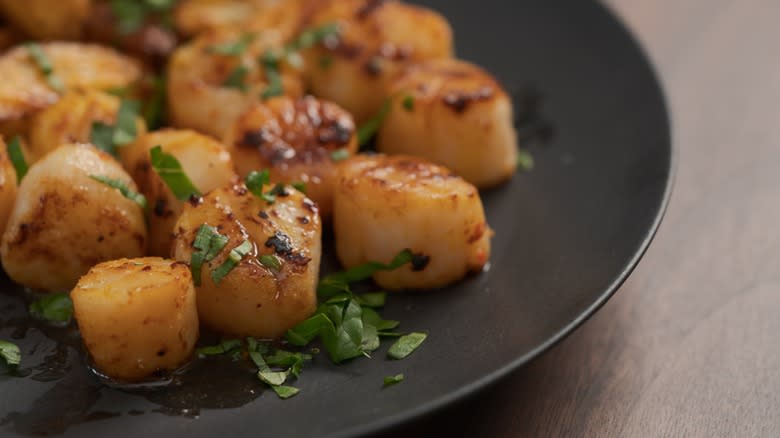
The best-known way of cooking scallops is in a scorching skillet on top of the stove. But that doesn't mean that's the only way to do it. There is a range of cooking options available to make restaurant-quality scallops without having to sweat over your hobs and risk a pan-fire. In-home kitchens, too, you might find that it's better to cook scallops using an alternative method if your stove can't reach the high temperatures required.
Broiling is a great way to cook multiple scallops in one go while still achieving a good color on their surface. Skewer scallops onto a metal or pre-soaked wooden skewer, brush them with oil or clarified butter, and then pop them under the broiler for about five minutes on each side. The high heat of the broiler will give them a nice char, and they'll cook through in no time.
If you're looking to take things outdoors, remember that scallops respond very well to being grilled. Like frying, it's a great way to get a near-immediate sear, and it can also fill the scallops with a smoky flavor. You can also bake scallops, which is a great way to cook them gently but thoroughly and to prepare multiple scallops at once.
Forgetting That You Can Enjoy Them Raw
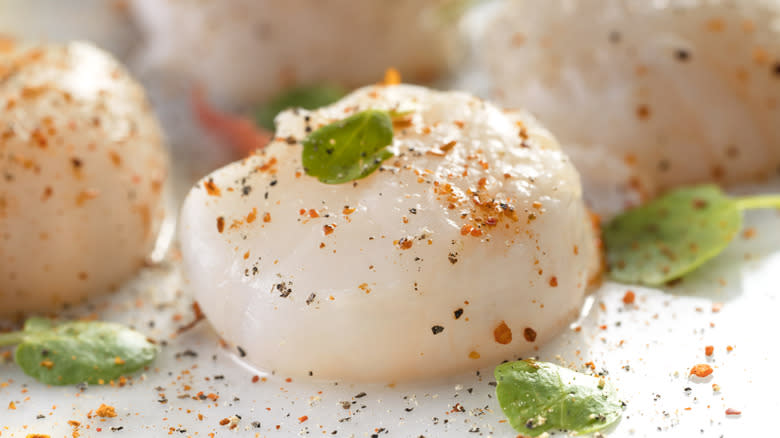
A lot of fuss can be made about cooking scallops. But one of the biggest mistakes that people make is forgetting that scallops don't have to be cooked at all. Like other types of seafood, scallops are perfectly edible when raw, provided that they have been handled and stored correctly. Raw scallops are usually more tender than their cooked counterparts and may retain more of their natural flavor. They can also be more nutrient-rich as no vitamins or minerals are eradicated in the cooking process.
Naturally, though, you'll want to make sure you're buying the freshest scallops possible if eating them raw. The key is to buy from a fishmonger and to ask for "day boat" scallops. These scallops (which are also known as "diver" scallops, or perhaps more commonly, "dry" scallops) are fished and brought into the harbor within 24 hours, as opposed to sitting on a trawler for days straight. This ensures that you're getting the newest product possible, therefore limiting the possibility that it's gone bad or picked up bacteria en route. Make sure you keep them chilled until ready to serve and eat. We recommend serving raw scallops with simple flavors, like lemon juice and chili flakes, to make the most of their freshness.
Read the original article on Daily Meal.

